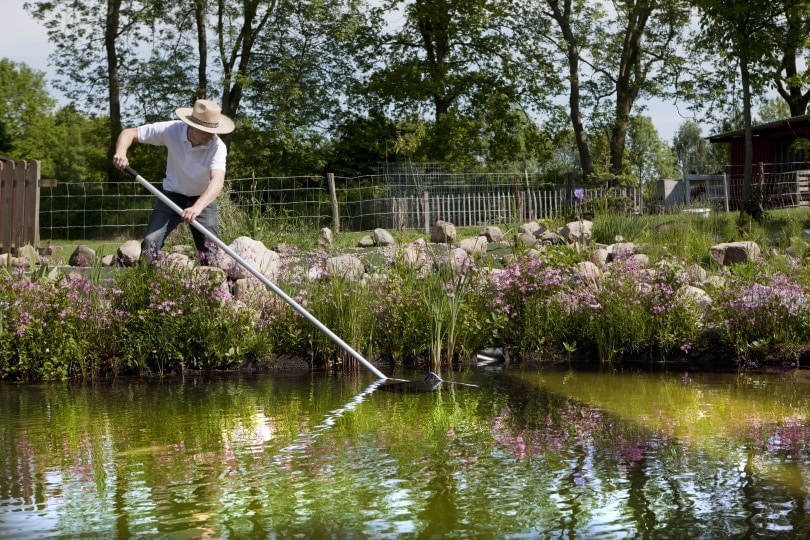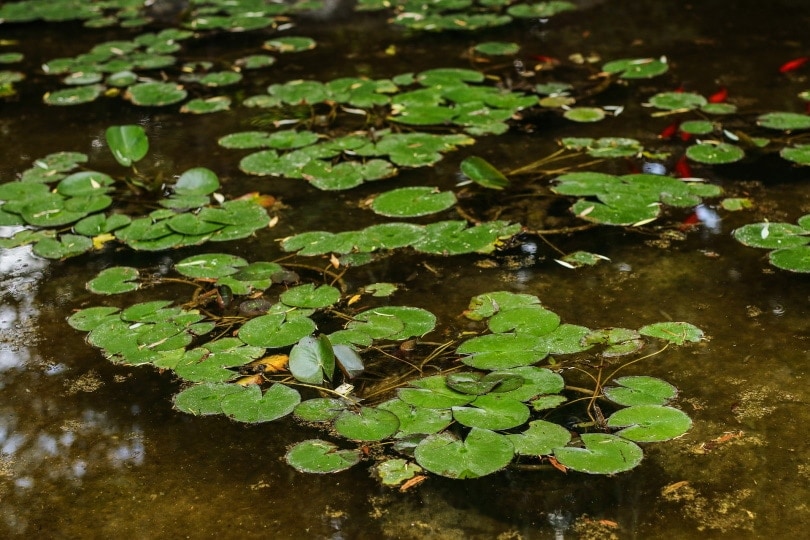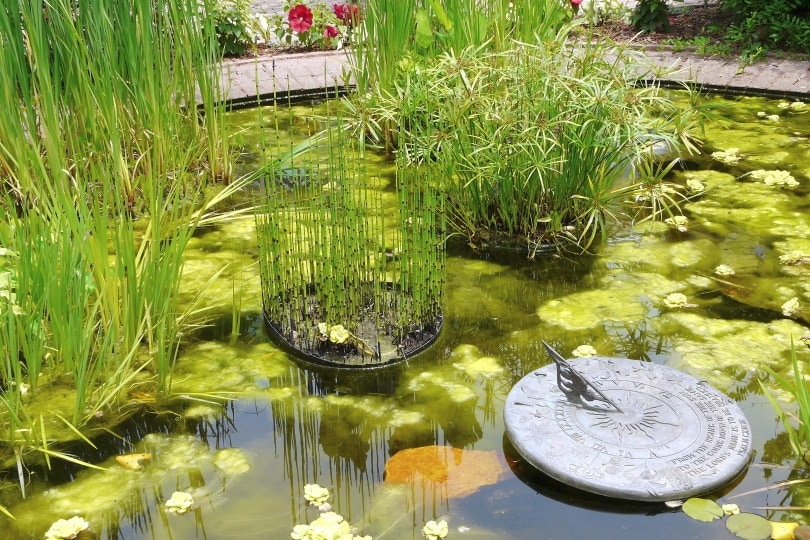Pond scum is a term that covers a few different things that could be appearing in your pond that affect its overall appearance. The most common form of pond scum is filamentous algae and it forms hair-like masses on the surface of the water reminiscent of moss. If you touch the green surface of your pond and it’s slimy, then you likely have a form of algae. There are also common weeds that appear in home ponds, such as the gritty watermeal, or duckweed, which looks like clovers and floats on the surface of the water.
One, or all, of these items can cause irreparable harm to your fish by reducing oxygen levels, so it’s important to take care of pond scum as quickly as possible.

Where Does Pond Scum Come From?
Pond scum forms when there are increasing levels of nutrients in your pond. This often happens in summer when the daylight hours increase and the water temperature rises in your pond. If you overfeed your fish, forget to clean the filters, overstock the pond, or don’t clean it properly, you’ll likely end up with pond scum. Algae begins to form on the bottom and sides of the pond. When the algae release oxygen as part of the process of photosynthesis, the algae rises to the surface, spreading rapidly and making your pond look like a bog or swamp.
Additional debris, such as leaves and twigs, add to the problem and will need to be removed as well.
The 4 Steps to Get Rid of Pond Scum Safely
1. Find the Root Cause of Pond Scum
It’s important to find out the cause of the extra nutrients that are helping to feed the pond scum. This could be from overfeeding your fish or providing the fish with low-quality food that is not digested probably, leading to more nutritionally dense waste from the fish. Ponds can also inadvertently receive fertilizers from water run-off, which provides the nutrients needed for pond scum.
This can even happen with lined ponds when the liner develops a leak. New ponds are usually lacking in beneficial bacteria that mature ponds have developed over time to combat pond scum. For the successful removal of pond scum, you need to find the cause and take care of the problem.
2. Remove the Pond Scum
After you’ve fixed the problem causing your algae growth, remove the pond scum using a garden rake, or skimmer, and throw it out in your trash can or a debris pile far away from your pond. When you have removed the larger pieces of algae matting from the pond, you can use a pond vacuum, such as the OASE Pondovac 3 Pond Vacuum Cleaner, to clean the rest of the debris from the pond’s bottom and sides. Vacuum slowly to avoid stressing out your fish.
You can also use a chemical algae control product. API Pond Algaefix Algae Control Solution is an herbicide that when used properly will kill algae as it begins to bloom. Determine the correct dosage for your pond before treating and then make sure to remove the dead algae with a rake.

3. Use Aquatic Plants to Prevent Algae
Since sunlight largely contributes to algae growth, it’s important to give your pond the right amount of shade to prevent algae while still giving your fish the sunlight they need. You’ll want a blend of free-floating and aquatic plants in containers to place throughout 50–70% of your pond to give it the correct amount of shade. Plants will help keep the bacteria growth to the correct level by adding to the nutrient balance in the pond, plus they serve as protection for your fish from predators.
Here is a list of some plants that do well in home ponds:
- Water hyacinth (Eichhornia crassipes)
- Horsetail rush (Equisetum hyemale)
- Taro (Colocasia esculenta)
- Water iris (Iris ensata)
- Ogon Golden Sweet Flag (Acorus gramineus Ogon)
- Water lilies (Nymphaea odorata)
4. Add Other Preventives to Your Pond
Summit Clear-Water Barley Straw Pond Treatment can be submerged beneath the water of your pond to help fight algae. The barely straw breaks down over time and releases humic acid that interacts with surface water to create hydrogen peroxide. The oxygen is reduced in the water which means algae can’t grow. Determine the right amount for your pond size as you do not want to cause harm to your fish by reducing the oxygen levels below what is needed for them to survive in your pond.
Another option is using bacteria tablets to help your pond create a natural balance of bacteria and nutrients. API Pond-Zyme Sludge Destroyer Pond Sludge Remover uses bacteria strains to break down dead algae, fish waste, and debris that clogs filters.

Additional Tips
In addition to the steps listed above to get rid of pond scum, there are some other steps you can take to keep pond scum from returning. You’ll need to check your filtration systems regularly and replace filters as needed. You can increase water circulation and aeration in your pond to help prevent pond scum. Do not over-feed your fish and reduce the stock if there are too many fish present for the pond size. You can also add a popular algae-eating pond fish called the Common Pleco to your stock to help keep your pond healthy.

Final Thoughts
Pond scum may be unsightly, but the good news is that it is treatable without harming your fish. Taking the time to remove the algae debris, vacuum the pond, and treat it with chemicals, or natural and bacterial treatments will go a long way toward getting rid of pond scum. To keep pond scum from coming back, check your filtration systems, increase circulation and aeration, and don’t over-feed your fish. Installing aquatic plants will not only help to prevent pond scum from occurring but will also give your pond a pleasing aesthetic.
Pond scum is treatable, and you’ll soon have your beautiful, clear pond back if you follow the correct steps to remove it.
Read More: How to Get Rid of Pond Weeds
Featured Image Credit: romarti, Shutterstock
